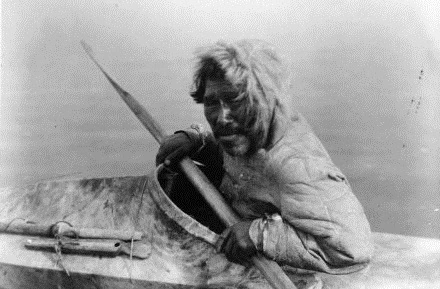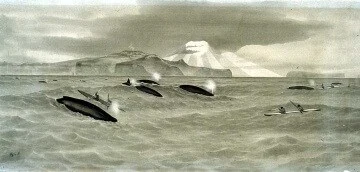Sea kayaking is a technology that is at least 4,000 years old. Peoples of the high northern latitudes (Greenland, Alaska, Russia, and Canada) were the first to invent wood- or whale bone-framed boats covered with a watertight skin. Some experts claim the Inuit were the first to invent these ingenious boats while others suggest it was the Ainu or Aleut. The modern name “kayak” is derived from the ancient Aleutian “iqyak“, meaning “man-boat” or “hunters-boat.” The hunter’s family would carry camp and supplies in a larger type of kayak called an “umiak”.
The earliest and most primitive kayaks were built for calm waters such as rivers, estuaries and bays. The first true sea kayaks did not develop until both paddling skills and kayak design theory matured. Sea kayaks evolved into the ideal vessel for aboriginal hunting and fishing cultures due to their inherent stealth.

There seems to be no limit as to the size of prey that could be taken from a sea kayak. Targets hunted from kayaks include seals, walruses, whales and caribou. In the late 1700s, Russian fur traders enslaved native hunters from Alaska and organized vast fleets of kayaks that swept south all the way to San Francisco Bay in pursuit of sea otter pelts.

No one is sure exactly when the first kayak made its way to Europe. However, several trans-Atlantic kayak journeys from Labrador or Greenland to Scotland were endured by adventurous Inuit paddlers in the 1800s. Kayaks soon caught on in Europe, with canvas substituting for traditional skin covers. European craftsmen and naval architects took their turns at attempting to improve the kayak, but the aboriginal designs proved to be quite mature and highly-evolved. In fact, at the hands of Europeans, both kayak designs and paddling skills deteriorated drastically from the highly refined principles of the native kayakers.

Kayak designs began to advance in the 1950s with the advent of modern materials such as fiberglass and rubberized fabric. Ironically, the thrust of these “modern advancements” led to a revival of traditional Inuit kayak designs. Today, the very best modern kayaks still look, feel, and perform very much like kayaks made centuries ago. Whereas the hulls are very traditional in shape, significant to improvements can be seen in hatches, bulkheads, seats, and other features. It turns out that even our best computer software for naval engineering cannot improve on the intuitive genius of the kayak’s original innovators.

